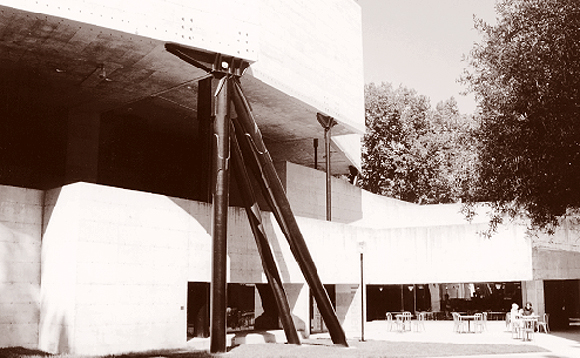Mario J. Ciampi is a remarkably animated, knowledgeable, and energetic nonagenarian who talks enthusiastically about the things that interest him: urban planning, the Dogon people of West Africa, the great pyramid of Cheops, the state of education in the United States, and the necessity for architecture to achieve greater harmony with the laws of the universe. Unrolling the much-handled floor plans for the Berkeley Art Museum, he delights in explaining the intricacies of its design.
“The space of the museum contains pure, dynamic energy,” he says. According to him, the late Pier Luigi Nervi proclaimed it “one of the most brilliant pieces of engineering he had ever seen.” To Mr. Ciampi, “the character of the building transcends architecture.” He feels that there is “nothing on the planet like it,” and that the space has, to this date, not been fully comprehended. What he speaks very little about is the imminent danger that confronts what many consider his magnum opus.
The largest university art museum in the world when it was built in 1970, the cast concrete building by Mr. Ciampi, Richard Jorasch, and Ronald Wagner features ramped galleries and cantilevered balconies that overlook a soaring central atrium, forming an austere poetry of colliding geometries. It looks to be a building for the ages.
In fact, however, the museum has undergone a multi-million dollar retrofit just to upgrade it to a “poor” seismic rating from the “very poor” one attributable to damage from the Loma Prieta earthquake. The cost of further retrofitting, an increased demand for useable space, a readily available, alternative site, and willing donors may well contribute to its demise.
“In its present form, the museum has limited exhibition and education spaces and is not equipped to present some of the newest developments in multi-media art and installations,” says Rod Macneil, Deputy Director of Public Relations and Marketing for the museum. “A new facility could include additional classrooms and expanded exhibition space, as well as an additional theater for the Pacific Film Archive.”
A final decision is expected from the UC Regents, the Chancellor, and the Executive Campus Planning Committee sometime in the fall. Unless something truly remarkable occurs, the handwriting materializing on the wall of the Ciampi/ Jorasch/Wagner building will soon be legible to all.
Author Lynne D. Reynolds, AIAS, is a second-year student in the architecture program at CCAC (California College of Arts and Crafts) who spent most of the previous two decades as a professional photographer of furnishings and interiors.
Photo by Supreeya Pongkasem.
Originally published 3rd quarter 2002, in arcCA 02.3, “Building Value.”






